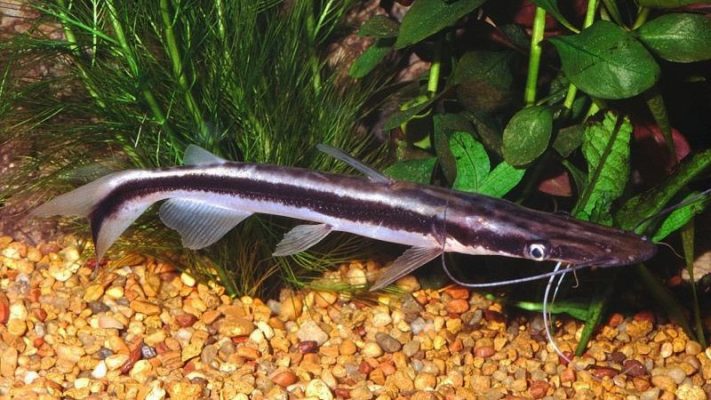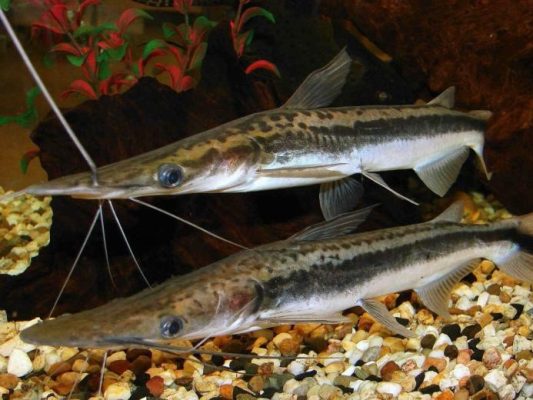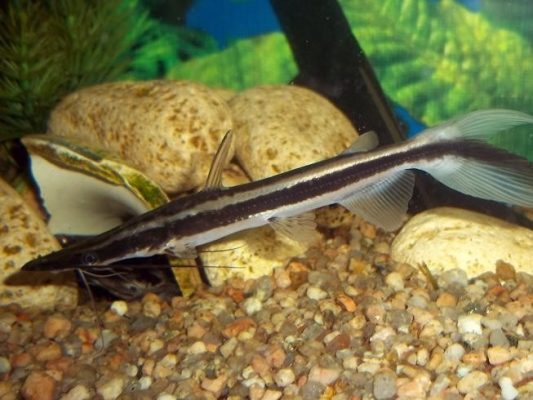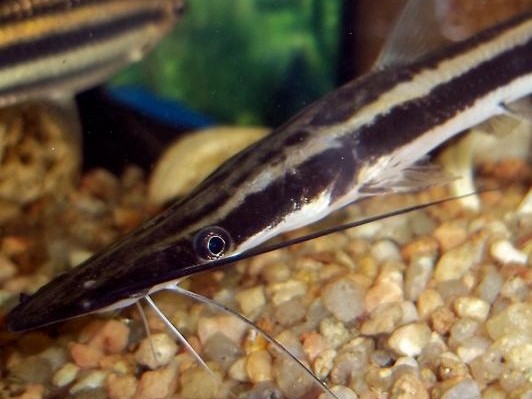Lima Shovelnose Catfish

Table of Contents
Introduction
The Lima shovelnose catfish, scientifically known as Sorubium lima, is a fascinating species of catfish that captures the attention of aquarium enthusiasts and researchers alike. Belonging to the family Pimelodidae, this unique catfish is characterized by its distinctive shovel-like nose, which sets it apart from other catfish species.
In the aquarium hobby, the Lima shovelnose catfish is highly sought after due to its striking appearance and intriguing behavior. Its sleek body, adorned with intricate patterns and colors, adds a touch of elegance to any aquarium. Moreover, its active nature and adaptability make it an interesting species to observe and study.
Beyond its allure in the aquarium trade, the Lima shovelnose catfish plays a crucial role in maintaining the delicate balance of the aquatic ecosystem it inhabits. As a predator, it helps regulate the population of smaller fish species, contributing to the overall stability of the food chain. By controlling the abundance of prey species, it prevents overpopulation and ensures the survival of other organisms in the ecosystem.
Additionally, the Lima shovelnose catfish is known for its ability to adapt to different environmental conditions. This adaptability allows it to thrive in various habitats, making it a resilient species capable of surviving in changing ecosystems. Its presence in rivers, streams, and flooded forests indicates the health and diversity of these habitats.
In this article, we will delve into the intricate world of the Lima shovelnose catfish, shedding light on its habitat preferences, physical attributes, behavior, conservation status, and the interactions it has with humans. By examining these aspects, we aim to deepen our understanding of this remarkable species and emphasize the importance of its conservation.
Throughout the article, we will provide evidence-based information, drawing from scientific studies and expert opinions to present a comprehensive and accurate portrayal of the Lima shovelnose catfish. By doing so, we hope to not only educate and engage our readers but also inspire a sense of appreciation and responsibility towards the conservation of this magnificent species.
Habitat and Distribution
Description of the natural habitat of the Lima shovelnose catfish
The Lima shovelnose catfish, belonging to the Sorubium lima genus, is primarily found in the freshwater rivers, streams, and flooded forests of South America. These habitats provide the necessary conditions for the species to thrive and fulfill their ecological role.
One of the key aspects of the Lima shovelnose catfish’s preferred habitat is the presence of flowing water. The constant movement of water ensures a continuous supply of oxygen, which is vital for the survival of the species. Additionally, the flow of water helps to disperse waste and maintain water quality.
Vegetation plays a crucial role in the habitat of the Lima shovelnose catfish. They seek out areas with dense vegetation, such as submerged plants, fallen trees, and root systems. These provide hiding spots and cover, allowing the catfish to evade predators and ambush their prey. The vegetation also serves as a source of food, as it attracts smaller organisms that the catfish can feed on.
Furthermore, the Lima shovelnose catfish is known to inhabit areas with sandy or muddy bottoms. These substrates provide ideal conditions for the catfish to burrow and create nests for spawning. The burrows also offer protection and shelter during periods of high water flow or adverse environmental conditions.
Geographical distribution and range of the species
The Lima shovelnose catfish is native to several countries in South America, including Brazil, Peru, Colombia, and Venezuela. Within these countries, the species can be found in various regions and river systems.
In Brazil, the Lima shovelnose catfish is commonly found in the Amazon River and its tributaries, such as the Rio Negro and the Rio Madeira. These rivers provide extensive habitats with diverse ecosystems, allowing the catfish to occupy different niches and adapt to varying environmental conditions.
In Peru, the species is often found in the rivers of the Amazon basin, including the Ucayali, Marañón, and Napo rivers. These waterways offer a rich and interconnected network of habitats, supporting a wide range of aquatic species.
Colombia is another country where the Lima shovelnose catfish can be found, particularly in the rivers of the Orinoco basin, such as the Meta and Guaviare rivers. These rivers provide important migration routes and breeding grounds for the species.
Factors influencing the choice of habitat for the Lima shovelnose catfish
The Lima shovelnose catfish is highly adapted to specific environmental conditions, and several factors influence its choice of habitat.
Water temperature is a critical factor for the species, as it affects their metabolism and overall physiological functions. The catfish prefers water temperatures ranging from 24 to 28 degrees Celsius (75 to 82 degrees Fahrenheit). These temperatures provide optimal conditions for their growth, reproduction, and overall well-being.
The pH level of the water also plays a significant role in the habitat selection of the Lima shovelnose catfish. They thrive in slightly acidic to neutral water, with a pH range of 6.5 to 7.5. Extreme fluctuations in pH can be detrimental to their health and survival.
Water hardness, determined by the concentration of dissolved minerals, is another important factor. The Lima shovelnose catfish prefers moderately hard water, with a range of 8 to 12 degrees of general hardness (dGH). Adequate water hardness is essential for maintaining the catfish’s osmotic balance and supporting their physiological processes.
Food availability is a crucial consideration for the Lima shovelnose catfish when selecting their habitat. They are opportunistic predators, feeding on a variety of small fish, crustaceans, and insects. Therefore, they prefer habitats with abundant prey populations, such as areas with high biological productivity and diverse food sources.
Water quality is also a significant factor influencing the choice of habitat for the Lima shovelnose catfish. They require well-oxygenated water with low levels of pollutants and contaminants. Pollution from human activities, such as industrial waste and agricultural runoff, can have detrimental effects on their health and survival.
In summary, the Lima shovelnose catfish prefers habitats with flowing water, dense vegetation, sandy or muddy bottoms, and specific water conditions, including temperature, pH, hardness, food availability, and water quality. Understanding these habitat preferences is crucial for conservation efforts and ensuring the long-term survival of this unique species.
Physical Characteristics
Size and weight range of the Lima shovelnose catfish
The Lima shovelnose catfish is known for its impressive size, with average individuals ranging from 12 to 24 inches in length. However, they have been known to grow even larger, with some individuals reaching lengths of up to 36 inches. The weight of the Lima shovelnose catfish can vary greatly depending on factors such as age, diet, and habitat conditions. On average, adult Lima shovelnose catfish weigh between 5 to 15 pounds, but larger specimens can weigh up to 30 pounds or more.
The size of the Lima shovelnose catfish is influenced by various factors. Firstly, their habitat plays a significant role in determining their size. In areas with abundant food resources and suitable conditions, Lima shovelnose catfish tend to grow larger. Additionally, their diet also affects their size, as individuals with access to a diverse range of prey items are more likely to grow larger than those with limited food sources.
External features, including body shape, coloration, and unique adaptations
One of the most distinctive features of the Lima shovelnose catfish is its shovel-like nose, which gives it its name. This elongated snout is flattened and broad, resembling the shape of a shovel. The purpose of this unique adaptation is to help the catfish search for food in the sandy or muddy substrate of its habitat. By using its shovel-like nose, the Lima shovelnose catfish can sift through the sediment, searching for small invertebrates and other prey items.
In terms of coloration, the Lima shovelnose catfish typically has a dark brown or blackish body, which helps it blend in with its surroundings. This coloration provides camouflage and allows the catfish to remain hidden from potential predators or prey. Additionally, they may have lighter colored spots or patterns on their body, which can vary in intensity and distribution among individuals. These patterns serve as another form of camouflage, further aiding in their ability to blend into their environment.
The body shape of the Lima shovelnose catfish is elongated and streamlined, which allows for efficient movement through the water. This sleek body shape enables them to navigate swiftly and with agility, making them effective predators in their natural habitat. Furthermore, they possess sharp pectoral and dorsal spines, which serve as a defense mechanism against potential threats. These spines can be erected when the catfish feels threatened, providing protection against predators or other aggressive individuals.
Internal anatomy and physiological adaptations for survival
The internal anatomy of the Lima shovelnose catfish is well-adapted to its aquatic environment. Like other catfish species, they possess a bony skeleton, which provides support and structure to their body. This skeletal structure allows them to withstand the pressures and movements associated with swimming and feeding.
One of the notable physiological adaptations of the Lima shovelnose catfish is their ability to breathe air. While they primarily obtain oxygen through their gills like other fish, they also possess a specialized structure called a labyrinth organ. This organ allows them to extract oxygen from the air when water conditions are poor or oxygen levels are low. This adaptation enables them to survive in environments with fluctuating oxygen levels, such as stagnant or oxygen-depleted waters.
Another important physiological adaptation of the Lima shovelnose catfish is their ability to detect electrical signals. They possess specialized cells called electroreceptors, which are located on their body, particularly around their head and snout. These electroreceptors allow them to detect weak electrical fields produced by other organisms, such as prey or potential predators. This sensory adaptation helps them locate and capture prey, as well as avoid potential threats in their environment.
In conclusion, the Lima shovelnose catfish exhibits remarkable physical characteristics and physiological adaptations that contribute to its survival in its natural habitat. From its size and weight range to its unique shovel-like nose and coloration, these features enable the catfish to thrive in various aquatic environments. Additionally, its internal anatomy, including its bony skeleton and specialized organs, allows it to navigate and adapt to different conditions. Understanding these physical characteristics and adaptations is crucial for appreciating the Lima shovelnose catfish’s role in the aquatic ecosystem and implementing effective conservation measures to ensure its long-term survival.
Behavior and Reproduction
Feeding habits and diet preferences of the Lima shovelnose catfish
The Lima shovelnose catfish, known for its predatory nature, has a diverse diet consisting of various aquatic organisms. In the wild, their diet primarily includes small fish, crustaceans, insects, and other invertebrates. These catfish are opportunistic feeders, meaning they will consume any available food source that fits within their mouth.
To locate and capture their prey, Lima shovelnose catfish rely on their highly developed sensory systems. Their barbels, which are elongated sensory organs located near their mouth, help them detect movement and vibrations in the water. This allows them to locate potential prey even in low-light conditions or murky waters.
Once the prey is detected, the Lima shovelnose catfish uses its powerful suction-like mouth to capture it. They have a unique feeding behavior where they rapidly extend their mouth forward, creating a vacuum that sucks in the prey. This feeding mechanism is highly efficient and enables them to capture fast-moving prey.
Nocturnal behavior and adaptation to low-light environments
The Lima shovelnose catfish is primarily nocturnal, meaning they are most active during the night. This behavior is believed to be an adaptation to avoid predators and take advantage of the reduced competition for resources during the dark hours.
To navigate in low-light conditions, Lima shovelnose catfish rely on their well-developed sensory systems. Their eyes have adapted to low-light environments, allowing them to see in dimly lit waters. Additionally, they possess a specialized structure called the tapetum lucidum, which enhances their ability to gather and reflect available light, further improving their vision in the dark.
Furthermore, these catfish have a keen sense of smell, which helps them locate food sources and potential mates. They have specialized olfactory receptors that can detect and discriminate various chemical cues in the water, allowing them to navigate and find suitable habitats and food sources.
Social behavior and interaction with other species
The Lima shovelnose catfish exhibits a relatively solitary behavior in the wild, often being found alone or in small groups. They are generally not aggressive towards other fish species and can coexist peacefully in a community aquarium. However, it is important to consider their predatory nature and potential size when selecting tank mates.
In a community aquarium, Lima shovelnose catfish are best kept with larger, non-aggressive fish that are too large to be considered prey. They may show territorial behavior if their space is invaded, so providing adequate hiding spots and territories within the aquarium is essential to reduce potential conflicts.
Reproductive strategies, including mating rituals, spawning, and parental care
The reproductive behavior of the Lima shovelnose catfish is fascinating and complex. They are oviparous, meaning they reproduce by laying eggs. During the breeding season, which typically occurs during the rainy season, males and females engage in courtship rituals to initiate mating.
Males will actively pursue females, often displaying aggressive behavior towards rival males. Once a male successfully courts a female, they will engage in a unique courtship dance, where the male will swim around the female, rubbing his body against hers. This behavior is believed to stimulate the female and trigger the release of eggs.
After successful mating, the female Lima shovelnose catfish will lay her eggs in a carefully chosen location, typically in a secluded area with vegetation or a suitable substrate. The male will then fertilize the eggs externally by releasing his sperm over them. Once fertilized, the eggs will hatch within a few days, depending on the water temperature.
Unlike some other catfish species, Lima shovelnose catfish do not exhibit parental care after the eggs hatch. The fry, or newly hatched fish, are left to fend for themselves and seek shelter in the surrounding environment. This reproductive strategy allows for a large number of offspring to be produced, increasing the chances of survival in the wild.
Breeding the Lima shovelnose catfish in a home aquarium can be challenging due to their specific breeding requirements. It is essential to provide appropriate water conditions, including temperature, pH, and water quality, to mimic their natural habitat. Additionally, providing suitable hiding spots and a separate breeding tank can increase the chances of successful breeding.
By understanding the feeding habits, nocturnal behavior, social interactions, and reproductive strategies of the Lima shovelnose catfish, we gain a deeper appreciation for this remarkable species. Their unique adaptations and behaviors contribute to their overall success in their natural habitat and highlight the importance of their conservation.
Conclusion
Recap of the main points discussed in the article
In the introduction, we introduced the Lima shovelnose catfish as a species belonging to the Sorubium lima genus, highlighting its unique characteristics and significance in the aquarium hobby.
Moving on to the importance and significance of the Lima shovelnose catfish in the aquatic ecosystem, we discussed its role in maintaining ecological balance as a predator and its impact on the food chain.
In the section on habitat and distribution, we described the natural habitat of the Lima shovelnose catfish, including rivers, streams, and flooded forests. We also provided information on its geographical distribution and range, highlighting specific regions or rivers where the species is commonly found. Additionally, we discussed the factors influencing the choice of habitat for the Lima shovelnose catfish, such as water temperature, pH, and water hardness.
Next, we delved into the physical characteristics of the Lima shovelnose catfish. We provided information on its size and weight range, explaining how these factors can vary based on habitat and diet. We also described its external features, including the unique shovel-like nose and distinctive coloration and patterns on its body. Additionally, we explored its internal anatomy and physiological adaptations for survival.
Moving on to behavior and reproduction, we discussed the feeding habits and diet preferences of the Lima shovelnose catfish, as well as its nocturnal behavior and adaptation to low-light environments. We also explored its social behavior and interaction with other species, as well as its reproductive strategies, including mating rituals, spawning, and parental care.
In the threats and conservation section, we identified both natural and human-induced threats to the Lima shovelnose catfish, including predation, competition, habitat destruction, and pollution. We also provided information on its conservation status and ongoing efforts to protect the species, highlighting the role of international organizations and legislation in conservation.
Moving on to human interactions, we discussed the importance of the Lima shovelnose catfish in local fisheries and aquaculture, as well as its economic significance and commercial value in the aquarium trade and culinary industry. We also emphasized the need for sustainable fishing practices and regulations to ensure its long-term survival, while addressing ethical considerations regarding its exploitation.
In the research and future directions section, we highlighted current research efforts and scientific studies focused on the Lima shovelnose catfish, as well as areas of further research and knowledge gaps. We also discussed the potential applications of research findings for conservation and management, emphasizing how scientific knowledge can inform conservation strategies and improve the species’ chances of survival.
Understanding and conserving the Lima shovelnose catfish is of utmost importance for the health and balance of the aquatic ecosystem. As we have learned, this species plays a crucial role in maintaining ecological balance as a predator and a key player in the food chain. Its unique adaptations and behaviors contribute to the overall biodiversity and stability of its habitat.
Conservation efforts are essential to ensure the survival of the Lima shovelnose catfish for future generations. The threats it faces, both natural and human-induced, pose significant challenges to its population and ecosystem. By understanding and addressing these threats, we can work towards preserving the species and protecting its habitat.
Looking ahead, the future prospects of the Lima shovelnose catfish are both promising and challenging. While ongoing conservation efforts and initiatives are making a positive impact, there is still much work to be done. Continued research and monitoring are necessary to fill knowledge gaps and better understand the biology, behavior, and conservation needs of the species.
It is crucial for individuals, communities, and governments to recognize the value of the Lima shovelnose catfish and actively contribute to its conservation. By appreciating and respecting this unique species, we can make a difference in its long-term survival. Whether through supporting sustainable fishing practices, advocating for habitat protection, or raising awareness about its importance, each individual can play a role in safeguarding the Lima shovelnose catfish and the aquatic ecosystems it inhabits.
The Lima shovelnose catfish is a fascinating species with a vital role in the aquatic ecosystem. By understanding its habitat, physical characteristics, behavior, threats, conservation needs, and human interactions, we can work towards ensuring its survival and preserving the delicate balance of our natural world. Let us embrace the responsibility to protect and conserve this remarkable species for future generations to appreciate and enjoy.



